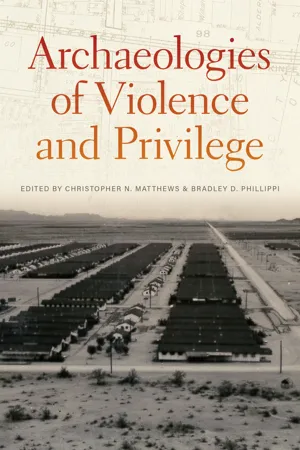
Archaeologies of Violence and Privilege
- 304 pages
- English
- PDF
- Available on iOS & Android
Archaeologies of Violence and Privilege
About This Book
Violence is rampant in today's society. From state-sanctioned violence and the brutality of war and genocide to interpersonal fighting and the ways in which social lives are structured and symbolized by and through violence, people enact terrible things on other human beings almost every day. In Archaeologies of Violence and Privilege, archaeologists Christopher N. Matthews and Bradley D. Phillippi bring together a collection of authors who document the ways in which past social formations rested on violent acts and reproduced violent social and cultural structures. The contributors present a series of archaeological case studies that range from the mercury mines of colonial Huancavelica (AD 1564–1824) to the polluted waterways of Indianapolis, Indiana, at the turn of the twentieth century—a problem that disproportionally impacted African American neighborhoods. The individual chapters in this volume collectively argue that positions of power and privilege are fully dependent on forms of violence for their existence and sustenance.
Frequently asked questions
Information
Table of contents
- Cover
- Half title
- Title
- Copyright
- Table of Contents
- List of Illustrations
- Chapter 1. An Introduction to Archaeologies of Violence and Privilege by Christopher N. Matthews and Bradley D. Phillippi
- Chapter 2. Violence in Archaeology and the Violence of Archaeology by Reinhard Bernbeck
- Chapter 3. Discursive Violence and Archaeological Ruptures: Archaeologies of Colonialism and Narrative Privilege in Highland Guatemala by Guido Pezzarossi
- Chapter 4. Spanish Colonialism and Spatial Violence by Kathryn E. Sampeck
- Chapter 5. “An Incurable Evil”: Direct and Structural Violence in the Mercury Mines of Colonial Huancavelica (AD 1564-1824) by Douglas K. Smit and Terren K. Proctor
- Chapter 6. The Violence of “A More Sensitive Class of Persons”: Privilege, Landscape, and Class Struggle in Northeast Pennsylvania by Michael P. Roller
- Chapter 7. Sifting through Multiple Layers of Violence: The Archaeology of Gardens of a WWII Japanese American Incarceration Camp by Koji Lau-Ozawa
- Chapter 8. Race and the Water: Swimming, Sewers, and Structural Violence in African America by Paul R. Mullins, Kyle Huskins, and Susan B. Hyatt
- Chapter 9. Binocular Vision: Making the Carceral Metropolis in Northern New Jersey by Christopher N. Matthews
- Chapter 10. Commentary: The Violence of Violence? by Louann Wurst
- Chapter 11. Forum: Thoughts and Future Directions
- References Cited
- List of Contributors
- Index